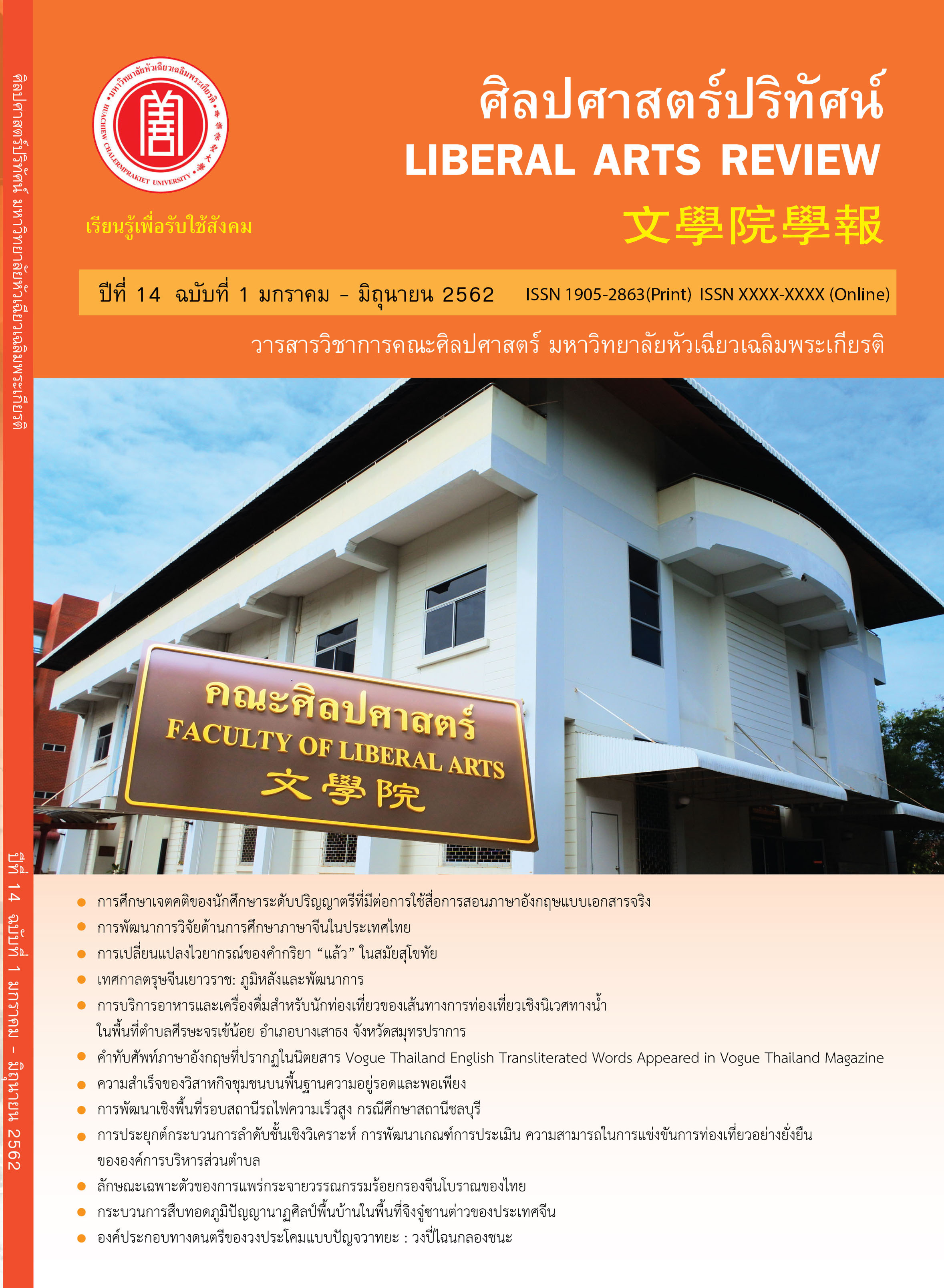Intellectual Inheritance of Ritual Folk Dance in JingzuSandao, China
Keywords:
Inheritance, Intellect Knowledge, Folk Dance, JingzuSandaoAbstract
The purpose of this research was to study about the folk dance on Ha Festival and the inheritance processes of ritual folk dance in JingzuSandao. This study is a qualitative research through collecting data from documents and field investigation, byusing methods of observation and in-depth interviews, then analyzing data and presenting the results in the descriptive analysis.
The study shows that: 1) Folk dance is apart of religious ceremony on Ha Festival; 2) All the folk dance performers are the married women of Jing nationality or the women who have married men of Jing nationality; 3) The dancing posture of folk dance may be originatedfrom nature or the Fisherman’s posture; 4) The dance props are incenses, plastic flowers, andchicken feathers or bird feathers, which may be the sacred animals for the Jing nationality; 5) The musical instruments of folk dance are the big drum, small drum, big gong and small gong. The rhythm from these musical Instruments makes the dance style more beautiful; 6) The contents of the songs which aresung on the ritual of Ha Festival, are about the way of life, beliefs, spirits and the traditions of Jing nationality.
There are three ways to inherit folk dance: by telling directly, through the ritual and the means of promotion. There are four factors that affect the inheritance of folk dance: The participants are not supported by the family, the participants rarely have time to attend training, the training department does not have a car to pick up participants, the shows paid for the local participants areless than the participants from Vietnam.
References
ชนาภา เมธีเกรียงไกร. (2559).กระบวนการสืบทอดประเพณีทางสังคมของชาวไทยเชื้อสายจีนชุมชนตลาดบ้านใหม่ จังหวัดฉะเชิงเทรา(วิทยานิพนธ์ปริญญามหาบัณฑิต). มหาวิทยาลัยบูรพา, ชลบุรี.
ชวโรฒน์วัลยเมธี. (2556). การศึกษาความสัมพันธ์ของนาฏศิลป์พิธีกรรมราชสำนักและพื้นบ้านของไทย (วิทยานิพนธ์ปริญญาดุษฎีบัณฑิต).จุฬาลงกรณ์มหาวิทยาลัย, กรุงเทพมหานคร.
ปรานี วงษ์เทศ. (2549).เพศสภาวะในสุวรรณภูมิ (อษุคเนย์).กรุงเทพมหานคร: มติชน.
ปิ่นเกศวัชรปาณ. (2560). เอกสารประกอบการสอนรายวิชานาฏศิลป์พื้นเมือง (Folk Dance). อุดรธานี: คณะครุศาสตร์มหาวิทยาลัยราชภัฏอุดรธานี.
ไพพรรณ เกียรติโชคชัย. (2541). กิจกรรมการศึกษาเพื่อการพัฒนาท้องถิ่น.กรุงเทพมหานคร: ศรีอนันต์การพิมพ์.
Siyuan, H. (2011).中国京族. Yinchuan: Ningxia People’s Publishing House.
Shixiong, L. (1987).谈京族哈节舞蹈. Journal of National Arts, 7(2), 152-159.
Xiaoming, H.,&Jingying, H. (2012).广西民间祭祀舞蹈文化田野考察与研究. Guilin: Guangxi Normal University Press.
Downloads
Published
How to Cite
Issue
Section
License
บทความที่ได้รับการตีพิมพ์เป็นลิขสิทธิ์ของวารสารศิลปศาสตร์วิชาการและวิจัย
ข้อความที่ปรากฏในบทความแต่ละเรื่องในวารสารวิชาการเล่มนี้เป็นความคิดเห็นส่วนตัวของผู้เขียนแต่ละท่านไม่เกี่ยวข้องกับมหาวิทยาลัยหัวเฉียวเฉลิมพระเกียรติ และคณาจารย์ท่านอื่นๆ ในมหาวิทยาลัยฯ แต่อย่างใด ความรับผิดชอบองค์ประกอบทั้งหมดของบทความแต่ละเรื่องเป็นของผู้เขียนแต่ละท่าน หากมีความผิดพลาดใดๆ ผู้เขียนแต่ละท่านจะรับผิดชอบบทความของตนเองแต่ผู้เดียว




